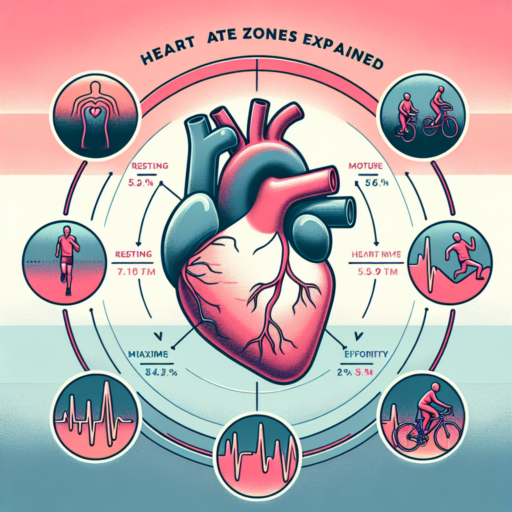No se han encontrado productos.
Understanding the Basics of Lactate Threshold Zones
The concept of Lactate Threshold Zones is integral to enhancing athletic performance and understanding how our bodies respond to intense exercise. This threshold signifies the point at which lactate begins to accumulate in the blood faster than it can be removed. Known also as the anaerobic threshold, crossing this limit can dramatically affect an athlete’s performance and endurance.
Essentially, the body utilizes two main types of energy systems: aerobic and anaerobic. During lower-intensity activities, the body primarily relies on the aerobic system, efficiently using oxygen to generate energy. However, as exercise intensity increases, crossing into the lactate threshold zone, the body shifts towards the anaerobic energy system. This shift marks a significant increase in lactate production, a byproduct of glucose breakdown without sufficient oxygen.
Understanding and identifying an individual’s lactate threshold can be pivotal for athletes aiming to optimize their training regimens. By training just below or at their lacticide threshold, athletes can encourage their bodies to become more efficient at processing and clearing lactate, thereby increasing their ability to perform at higher intensities for longer durations. It involves a delicate balance of training intensity and recovery, implementing strategic workouts that are specifically designed to push the limits of these threshold zones without surpassing them.
How Lactate Threshold Zones Improve Athletic Performance
Understanding lactate threshold zones is crucial for athletes striving to enhance their performance in their respective fields. These zones, which delineate the point at which the body starts to accumulate lactate faster than it can remove it, offer a framework for training sessions designed to increase endurance and speed. By focusing on training just below or slightly above their lactate threshold, athletes can push their limits safely and effectively.
The strategic manipulation of intensity within these zones can lead to remarkable improvements in athletic performance. Training in the lactate threshold zones facilitates a higher work rate for longer periods, which is vital for endurance athletes like marathon runners and cyclists. It is not just about building stamina; it is about enhancing the body’s ability to process and recycle lactate, thus delaying fatigue and improving overall performance.
Moreover, incorporating sessions that target these specific zones into an athlete’s training routine can significantly improve their metabolic efficiency. This means athletes will utilize energy sources more effectively during their performance, whether it’s tapping into fat reserves more efficiently or managing glycogen storage. This optimization of energy use is a game-changer for performance, enabling athletes to maintain a higher intensity for longer durations with less perceived effort.
Scientific Approach to Calculating Your Lactate Threshold
Lactate threshold is a critical metric for athletes across disciplines, defining the point at which lactate begins to accumulate in the bloodstream faster than it can be removed. This threshold marks a significant shift in metabolic processing and is pivotal for designing an effective training program. Understanding and calculating your lactate threshold through a scientific approach can drastically improve your athletic performance by tailor-making workout and recovery plans.
To precisely determine your lactate threshold, several scientific methods are employed, one of the most accurate being the graded exercise test (GXT). This method involves incremental increases in exercise intensity while measuring blood lactate levels. The point at which there is a notable increase in lactate concentration is identified as the lactate threshold. This process typically requires the assistance of a professional in a controlled environment to ensure accurate readings and interpretations.
Another approach involves estimating the lactate threshold through field tests like time trials or steady state workouts, which can then be approximated using various formulas. These methods, though slightly less precise than direct measurement, provide athletes with a ballpark figure that can still significantly guide training decisions. Implementing these scientific methods to calculate and understand your lactate threshold allows for optimized training intensity zones, ensuring both efficient energy use during exercise and effective recovery.
Training Within Your Lactate Threshold Zones for Optimal Results
Understanding and utilizing your lactate threshold zones can dramatically improve your training effectiveness and athletic performance. Lactate threshold (LT) refers to the point during exercise at which lactate starts to accumulate in the blood faster than it can be removed. Training just below or within this threshold can help you increase your stamina and efficiency, making it a critical concept for athletes to master.
Identifying Your Lactate Threshold Zones
To train effectively within your LT zones, you first need to identify your specific threshold. This can be done through a variety of tests, often conducted with the help of fitness professionals. Once identified, these zones serve as a guide to optimize your training, ensuring each session is precisely targeted to improve your endurance and performance.
Benefits of Training in Your LT Zones
Training within your lactate threshold zones offers numerous benefits. Firstly, it enables athletes to increase their endurance by teaching the body to use oxygen more efficiently and delay the onset of fatigue. Additionally, this type of training can improve cardiovascular health, as it effectively strengthens the heart and improves the body’s ability to supply oxygen to the muscles. Working within these zones also enhances metabolic efficiency, teaching the body to better utilize fat as a fuel source, conserving glycogen reserves for when they’re most needed.
Integrating Lactate Threshold Workouts into Your Exercise Routine
Understanding and integrating lactate threshold workouts into your exercise routine can significantly enhance your endurance and performance. The lactate threshold refers to the intensity of exercise at which lactate begins to accumulate in the blood. This point is critical for athletes who seek to improve their ability to sustain high-intensity efforts over a longer period. By focusing on exercises that push you just beyond this threshold, it’s possible to increase your body’s efficiency in processing lactate, thereby extending your capacity for more intense workouts.
One effective method for incorporating lactate threshold workouts is to begin with a solid base of steady-state endurance training. Once a solid foundation is established, introducing intervals that hover around your lactate threshold can propel your performance to the next level. This might involve sessions of intensive interval training – for example, cycling or running at a hard effort, just below the point of breathlessness, followed by periods of active recovery. The goal is to fluctuate around that critical threshold to improve your body’s lactate processing abilities.
To accurately target your lactate threshold, consider seeking out a professional assessment. This can provide you with precise heart rate zones or pace parameters to guide your training. However, a more accessible approach involves paying attention to your body’s signals. Typically, your lactate threshold aligns with an effort level where you can speak only a few words at a time. Training at or slightly above this intensity encourages your system to adapt, making it a potent component of your fitness regimen.
Sample Lactate Threshold Workouts
- Tempo Runs: These sustained efforts of 20-30 minutes are run at a «comfortably hard» pace, pushing your body to adapt to lactate accumulation.
- Interval Cycling: Alternating between 2-3 minutes of high-intensity cycling and 2 minutes of low-intensity cycling can boost your lactate processing.
- Swimming Intervals: Incorporating sets of 100-200 meters at near-maximal effort, followed by equal periods of rest, can enhance your threshold in the pool.
The Relationship Between Lactate Threshold Zones and Endurance
Understanding the intricate relationship between lactate threshold zones and endurance performance is crucial for athletes aiming to maximize their training outcomes. The body’s ability to manage lactate, a byproduct of anaerobic metabolism, influences an athlete’s endurance capacity. As intensity increases, so does the production of lactate, marking the body’s shift from relying predominantly on aerobic processes to more anaerobic sources of energy. Identifying an individual’s lactate threshold provides valuable insights into their endurance capabilities and helps in structuring targeted training programs.
The lactate threshold is commonly divided into different zones, each representing a specific intensity level and its corresponding metabolic stress on the body. Training within these zones can be strategically used to enhance an athlete’s endurance by improving their efficiency in lactate clearance and delay the onset of fatigue. This progression enables the athlete to sustain higher intensities for longer durations, a critical factor in endurance sports. Moreover, understanding these zones allows for the optimization of training loads, aligning them with the athlete’s physiological characteristics and endurance goals.
Integrating lactate threshold zone training into an athlete’s routine is not a one-size-fits-all strategy. It requires precise measurement through performance testing and ongoing adjustment to reflect improvements in endurance and shifts in threshold levels. As such, coaches and athletes often rely on regular assessment to tailor training sessions that focus on specific zones, thereby maximizing the effectiveness of each workout in building endurance. By systematically increasing the body’s threshold, athletes can significantly enhance their performance, highlighting the symbiotic relationship between managing lactate thresholds and achieving endurance milestones.
Techniques to Enhance Your Lactate Threshold for Competitive Sports
Certainly! Focusing on the specific topic of enhancing one’s lactate threshold for competitive sports, here are structured SEO-friendly portions of content designed to inform and engage:
Improving your lactate threshold is pivotal for athletes seeking to enhance their performance in competitive sports. This threshold determines the intensity at which your muscles start to rapidly fatigue due to lactic acid accumulation. Mastering techniques to elevate this threshold can be a game-changer in your overall athletic performance. By implementing strategic training methods, athletes can condition their bodies to tolerate higher levels of lactic acid, allowing them to sustain higher intensities for longer durations without succumbing to fatigue.
Interval Training: A Key Strategy
One of the most effective methods to increase your lactype = tolower(threshold is through interval training. This involves short bursts of high-intensity effort followed by periods of low-intensity recovery. Over time, interval training challenges your body to adjust to and clear lactic acid more efficiently, thus gradually elevating your lactate threshold. Incorporating varied intervals into your training routine not only boosts your endurance but also enhances your power and speed.
Steady-State Endurance Workouts
Alongside interval training, incorporating steady-state endurance workouts into your regimen can significantly contribute to raising your lactate threshold. These workouts entail maintaining a steady, moderate intensity over a prolonged period. They help condition your body to utilize oxygen more effectively for energy production, thereby delaying the onset of lactic acid accumulation. Regular steady-state sessions are crucial for building a solid endurance base, allowing you to perform better across various competitive sports.
By focusing on these techniques, athletes can significantly enhance their lactate threshold, leading to improved performance in competitive sports. Incorporating a diverse range of workouts that challenge both your anaerobic and aerobic systems is essential for comprehensive development. Remember, consistency is key to seeing progress; integrate these strategies into your regular training schedule to experience tangible improvements in your athletic capabilities.
Monitoring Your Progress: Tools and Technologies for Tracking Lactate Threshold
Understanding and tracking your lactate threshold is essential for athletes looking to optimize their performance. With the advent of innovative tools and technologies, monitoring your progress has never been more accessible. These advancements provide invaluable data, offering insights into your physical condition, and guiding your training decisions.
Wearable Fitness Trackers
Wearable fitness trackers have revolutionized the way athletes monitor their lactate threshold. Devices from brands like Garmin and Polar offer features that measure heart rate variability, recovery, and stress scores, indirectly indicating changes in your lactate threshold. By analyzing this data, athletes can adjust their training intensity, ensuring they are working in the correct zone to improve their endurance and performance.
Mobile Applications
Another pivotal development in tracking lactate threshold is the emergence of mobile applications. Apps such as Strava and TrainingPeaks allow users to upload data from their workouts, providing detailed analytics on their performance. These apps not only track your speed, distance, and heart rate but also offer insights into how your lactate threshold is improving over time. By mapping out your progress, these tools can be instrumental in planning future training sessions tailored to your growing capabilities.
Frequently Asked Questions About Lactate Threshold Zones
Understanding Lactate Threshold Zones is crucial for athletes aiming to optimize their performance. These zones represent the intensity at which lactate starts to accumulate in the blood, signaling a key tipping point for endurance and high-intensity training. Here, we address some common queries around this pivotal fitness metric.
What Determines Your Lactate Threshold Zone?
The Lactate Threshold Zone is influenced by several factors, including the individual’s fitness level, endurance capacity, and muscle fiber type composition. Generally, athletes with higher aerobic fitness levels can work at higher intensities before reaching their lactate threshold. This adaptability showcases the importance of personalized training programs designed to gradually elevate this threshold.
How Can You Test for Lactate Threshold?
Testing for your lactate threshold typically involves a graded exercise test conducted under the supervision of a fitness or medical professional. During the test, lactate levels in the blood are measured at regular intervals while exercise intensity is progressively increased. This method helps in accurately determining the intensity level at which lactate begins to accumulate, which is critical for setting targeted training zones.
Regular assessment of the Lactate Threshold Zone can significantly aid athletes and coaches in fine-tuning training regimens and developing strategies aimed at enhancing aerobic capacity and endurance performance. Recognizing the signs of approaching this threshold during workouts can also guide adjustments in intensity to stay within optimal training zones.
Case Studies: Success Stories of Training with Lactate Threshold Zones
Training with lactate threshold zones has emerged as a revolutionary approach for athletes seeking to maximize performance. This method, grounded in science, offers a tailored strategy to enhance endurance and speed. The impact of this training technique has been substantiated through numerous success stories, illuminating the practical virtues of understanding and leveraging one’s lactate thresholds.
One notable case involved a professional cyclist who, after plateauing for months, incorporated lactate threshold training into his regimen. The customization of his training plan, centered around his specific lactate threshold zones, resulted in a marked improvement in his race times and overall stamina. This is a testament to the efficacy of lactate threshold training in pushing athletic boundaries.
Another compelling example is that of a long-distance runner who struggled with late-race fatigue. Through the implementation of lactate threshold-based training sessions, she was able to significantly extend her ‘time to exhaustion’ and improve her finish times. Her training focused on pacing strategies and workouts designed around her lactate threshold data, illustrating how scientifically informed training can lead to tangible improvements in performance.




